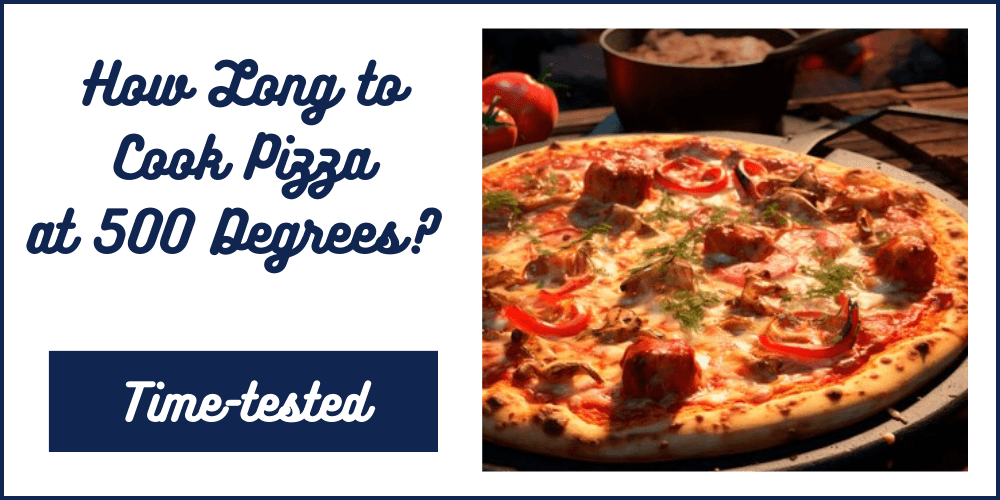
In the realm of culinary artistry, there exists a sacred temperature—500 degrees Fahrenheit—where the magic of pizza-making unfolds. From the simplicity of a classic Margherita to the complexity of avant-garde toppings, the perfect pizza beckons both novice cooks and seasoned chefs alike. Beyond the selection of quality ingredients, mastering the balance of time and temperature is the key to achieving that elusive harmony of crispy crust and melty cheese. So, How Long to Cook Pizza at 500 Degrees? Join us on a gastronomic journey as we unveil the secrets behind this culinary alchemy.
As we explore the science and technique of cooking at the golden 500 degrees, get ready to elevate your pizza game and turn your kitchen into a pizzeria. Preheat your ovens, don your aprons, and let’s dive into the captivating world of perfecting the art of pizza at 500 degrees.
How Long to Cook Pizza at 500 Degrees?
The ideal cooking time for a pizza at 500 degrees Fahrenheit depends on various factors, including the type of pizza, its thickness, and the desired level of crispiness. Generally, a higher temperature like 500 degrees Fahrenheit is used to achieve a quick and crisp cooking result, especially in professional pizza ovens.
The cooking time for a pizza at 500 degrees can range from 8 to 15 minutes, but it’s essential to monitor the pizza closely to prevent burning. Thin-crust pizzas typically require less time, around 8 to 10 minutes, while thicker or deep-dish pizzas may need 12 to 15 minutes.
One crucial consideration is the type of oven being used. Home ovens may have variations in temperature, and it’s advisable to use an oven thermometer to ensure accuracy. Preheating the oven is also crucial for achieving the desired crust texture. A preheated oven helps the pizza cook evenly and ensures a crispy crust while maintaining the desired chewiness inside.
Additionally, the type of pizza crust can influence the cooking time. A pre-baked crust might need less time in the oven compared to a raw or homemade dough. When using raw dough, a slightly longer cooking time may be necessary to ensure that the crust cooks thoroughly and achieves the desired golden brown color.
Toppings also play a role in determining the cooking time. Pizzas with a minimal amount of toppings may cook faster than those loaded with ingredients. For a well-balanced and thoroughly cooked pizza, it’s essential to distribute the toppings evenly and avoid overloading the crust.
Using a pizza stone or a pizza pan can enhance the cooking process. These tools help distribute heat evenly and contribute to a crispier crust. If using a pizza stone, it’s recommended to preheat it along with the oven for the best results.
In conclusion, when cooking a pizza at 500 degrees Fahrenheit, factors such as crust thickness, oven type, preheating, and toppings influence the cooking time. It’s a balance between achieving a crisp crust and ensuring that the toppings are cooked to perfection. Regular monitoring and adjusting the cooking time based on visual cues, such as crust color and cheese melt, will help you achieve the perfect pizza at this high temperature.
How long to cook pizza on 500?
For optimal results when cooking pizza at 500 degrees Fahrenheit, consider a few additional tips. Ensure the oven is well preheated to guarantee the crust cooks evenly and achieves the desired crispiness. If using a pizza stone, place it in the oven during the preheating stage to enhance heat retention and distribution. Rotate the pizza halfway through the cooking time to ensure uniform baking. It’s crucial to monitor the pizza’s progress, adjusting the cooking time based on visual cues such as the crust’s color and the cheese’s meltiness.
Keep in mind that individual ovens may have slight temperature variations, so experimentation may be necessary to find the perfect cooking time for your preferred pizza style. Lastly, allow the pizza to rest for a few minutes after baking to allow the cheese to set and make for easier slicing.
Is 500 degrees too hot for a pizza stone?
A pizza stone is typically safe to use at temperatures up to 500 degrees Fahrenheit (260 degrees Celsius). At this temperature, the stone can effectively transfer heat to the pizza crust, creating a crisp and evenly cooked result. However, exceeding this temperature may lead to potential risks. Prolonged exposure to extreme heat can cause the stone to crack or break. Additionally, excessive temperatures may result in an overly charred or burnt crust.
It’s crucial to follow the manufacturer’s recommendations for your specific pizza stone, as different materials and brands may have varying heat tolerances. Always preheat the stone gradually to minimize the risk of thermal shock and ensure a longer lifespan for your pizza stone while achieving optimal baking results.
Can you cook pizza in a 500 degree oven?
Yes, you can cook pizza in a 500-degree oven. Preheating the oven to a high temperature helps achieve a crisp crust and perfectly melted cheese. The intense heat allows for a shorter cooking time, typically around 10-15 minutes, ensuring the pizza cooks quickly and evenly. To prevent burning, use a pizza stone or place the pizza directly on the oven rack. The high temperature creates a desirable balance between a crispy exterior and a moist, flavorful interior.
It’s important to monitor the cooking process to achieve the desired level of doneness. Adjusting the temperature or cooking time based on the specific pizza recipe and personal preference can result in a delicious homemade pizza with a perfect combination of textures and flavors.
What is the minimum hot temp for pizza?
The minimum hot temperature for baking a pizza is typically around 450°F (232°C). This high temperature is crucial for achieving the desired crispy crust while ensuring the toppings cook evenly. The intense heat allows the dough to quickly rise and develop a golden-brown exterior, creating a perfect balance of textures.
Additionally, it helps melt the cheese and infuse the flavors of the toppings, contributing to the deliciousness of the final product. Cooking at lower temperatures may result in a less-than-ideal crust and unevenly cooked toppings, compromising the overall quality of the pizza.
Final Thoughts
Embarking on the culinary adventure of mastering the art of cooking pizza at 500 degrees is a captivating journey that demands a blend of experimentation and a discerning eye for detail. As you dive into the realm of pizza perfection, closely monitor your culinary creation, allowing the golden-brown crust to unfold its full potential.
Immerse yourself in savoring the delightful results that stem from the precise interplay of temperature and time. Soon, armed with the knowledge of ‘How Long to Cook Pizza at 500 Degrees?’ and the right culinary finesse, you’ll find yourself crafting pizzas that not only meet but surpass the standards set by your favorite pizzeria.
Sources:
- By Tom Chandler, How long does it take to bake a pizza at 400 degrees? uploaded 2 years ago.
Related posts:


